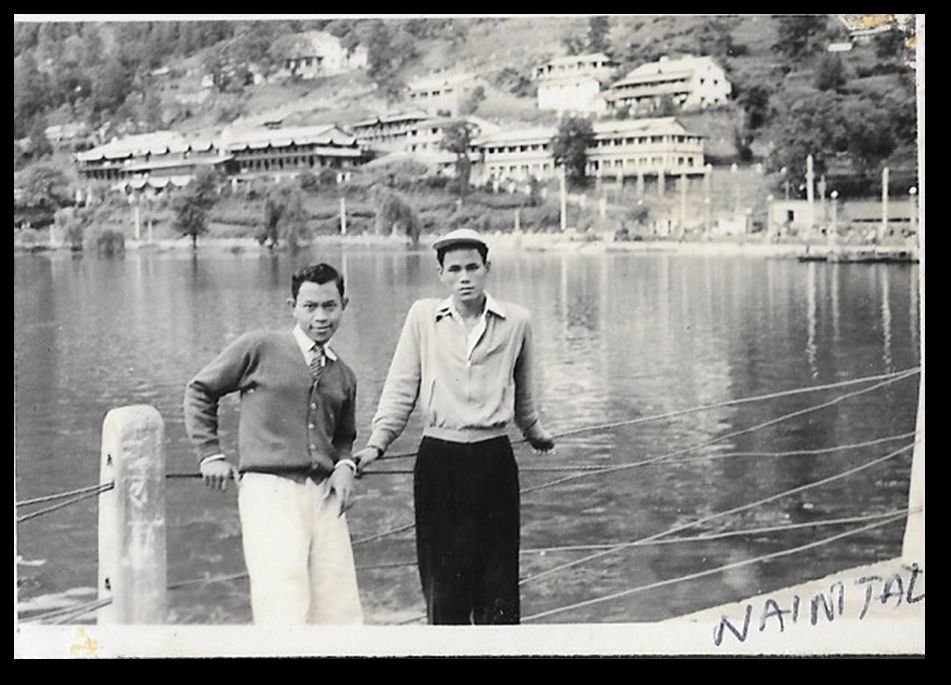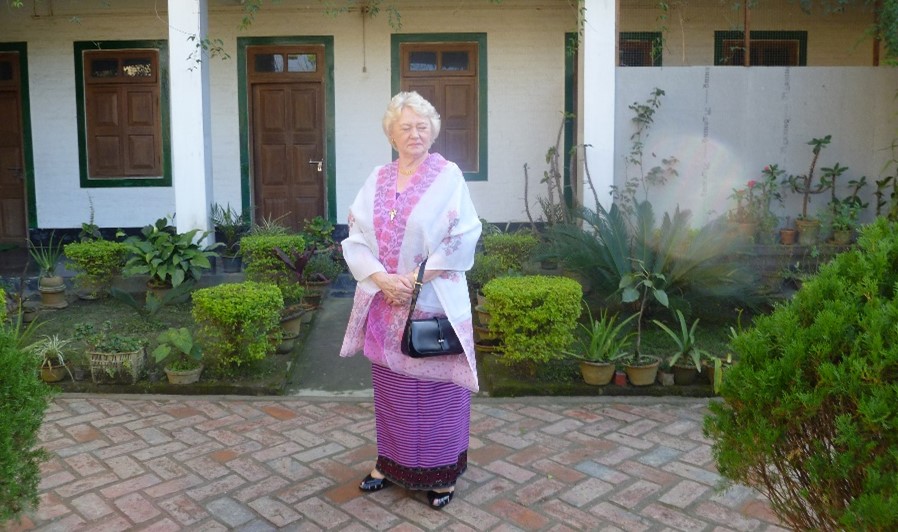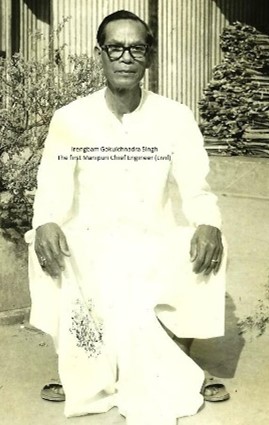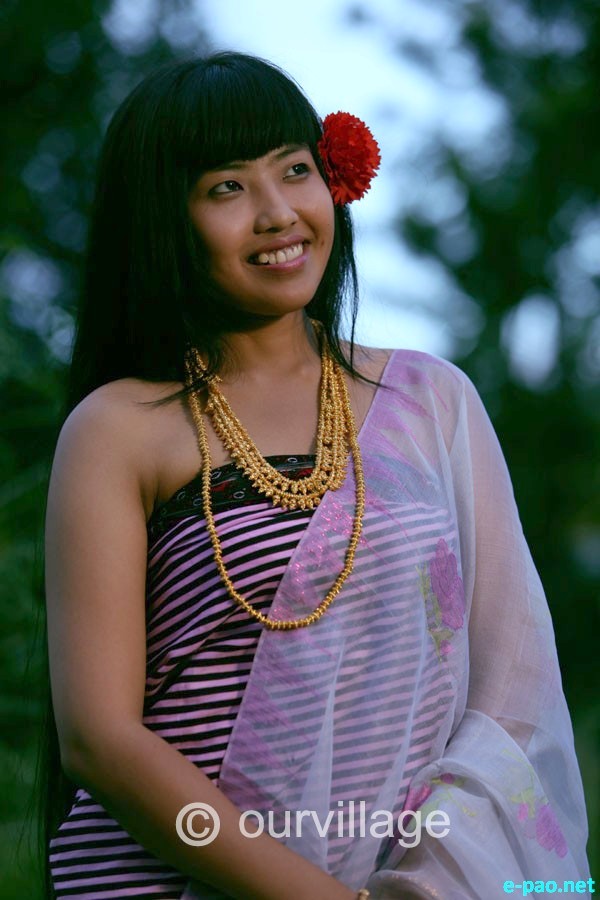My memories of Imphal from 1941
- Part 11 -
Dr Mohendra Irengbam *

(L-R) ex-Judge RK Sanatombi (Deceased), Author in 1955
Nainital in the Kumaon Hills in the central section of the Himalayas in the north, is one of the most captivating hill stations in India. The beautiful lake beckons you the moment you alight on its shore from a bus that brings you from Kathgodam, the railhead for Nainital. When I arrived there for the first time, from the hot and sweaty Delhi, it was like heaven on earth.
But coming back home to Imphal, was always 'sweet dreams guaranteed'. It began with the arresting premise that great strands of practice and culture that I learnt as I grew up, never changed. In the end for me, there was nothing like Meitei culture i.e. our shared values, beliefs, traditions, opinions and the like. I was wearing suit and tie all day for two years in Nainital while doing my B Sc. But back home in Imphal, in the hot summer, wearing a traditional khudei I felt quite comfortable and contented.
Manipur is in the eastern band of the Himalayas, which was uplifted from the sea, as part of the Northeast, 20-30 million years ago, when tectonic plates collided (cf. author's 'The Raising of Kangleipak from the bottom of the sea'). As of this month of December 2020, the Himalayas continues to be elevated and Mt Everest has gone taller by nearly a metre. Mt Everest was named after Sir George Everest, British surveyor General of India (1830-1843). As an upside of the Covid virus lockdown and the lack of atmospheric pollution, the people of Jalandhar in Punjab, can now see snow-picked Himalayas, about 200 km away.
Manipur has been described as 'a little paradise on earth'. Like the 'Birds of the Paradise flower', this little paradise has been having its own peculiarities. Two of these were undoubtedly the aesthetic: women's attire and the hairstyle. Since ancient times, every Meitei woman who partook of fashion, either as a consumer or working bee, was hell-bent on varying degrees of fabulous.
But unlike Marie Antoinette, they had very little to fashion with. They had only 'phanek', especially 'Phanek Mapal Naiba', which also indicated who they were. It epitomised a sustainable Meitei culture – 'the social skin' as some anthropologist calls it.
Surprisingly, it was simply simple. A wrap-around sheet of home-made cotton or silk fabric, which goes one and half times over their busts and tucked in under the left armpit. It is tight-fitting and reaches down just below the calf. They leave the top bare, which is covered by an 'innafi' - a thin cotton piece of material usually white with a coloured border.
Phanek for young children, was worn around their waist, leaving the top bare. In modernity, young and adult women usually hang it around their waist and its skims the floor. A tight-fitting blouse goes with it. Broadly, there are two kinds of phanek: informal and formal.
The informal or daily wear is of many colours except black. For religious functions and mourning they dress in 'pongou phanek' (faint peach colour). The informal phanek is of light weight while the formal one is heavy. They are woven on the waist looms in half the width and the right length. The two 'halves' are stitched together lengthways by hand to make a phanek.

Phanek Mapal Naiba
The formal wear is called 'Phanek Mapal Naiba' - Phanek with borders (op cit). The edges of the bottom part of it are stitched up for about 6-7 cm so as not to be blown open by the wind. It is striped and is of various colours, running across the material.
It has a broad margin of about 12 cm at the top and bottom. There are sets of geometrical figures that are embroidered on them by hand using a needle and floss silk (home-made rough silk). The expensive ones are made of silk, which are worn on special social functions.
The women might wear a short jacket (phurit in Manipuri) in winter, which is made of velvet, usually green. The phurit reaches below the bust and has two long sleeves. In winter, women like men, have woollen shawls to wrap around.
Women of royalty have khongup (slippers). They were padded and the top was made of velvets of different colours. Meitei Pangal women (mixed breed of mayang Muslim men and Meitei women) were distinguished by having a narrow sheet about 80 cm wide, usually yellow (Khwangfee), wrapped around their waist and over the phanek, when they came to Ima keithel.
An emotional part of a Meitei girl's wedding was matched by her wedding dress. Since almost all weddings were arranged unlike these days, apart from a few who eloped, there was a lot of sadness on the part of the bride as she was to leave her parents' home and carefree childhood days for a strange household. There was something particularly compelling about the spectacle.
The bride was always drawn to that kind of intensity of emotions - a natural grief, signifying her apprehension about her departure to the groom's house. Ironically, when she came home for Mapam Chakkouba (customary lunch) in five days' time, she was in a hurry to return to her husband's home because of the newly acquired marital bliss.
The wedding dress is called 'potloi', which moves gracefully with the bride's determined stolid steps as she circles seven times round the bridegroom who is seated with an equally miserable, toned-down face. In ancient times, Meitei girls wore phanek and innafi at weddings. That changed to 'potloi', which graduated from its inception as an ankle deep floppy cotton skirt with decorative embroidery to the present ornate and cylindrical costume.

Modern potloi - the Meitei Traditional Bridal Costume by Jenny Khurai - Make-up Artist
As we all know, Maharaja Bhagyachandra (1759-1798) installed an idol of Govinda (another name of Krishna) at a temple at his Langthabal Palace in 1779. He then organised a ritualistic dance and music performance that became known as Ras Leela dance at the temple's mandab. He is reputed as having also introduced the 'potloi' costume as the uniform for the girls taking part in the Ras Leela.
The potloi was fashioned on the design of 'ghagara'- a long floppy skirt that women of Brindavan wear, and imaginatively, what Radha and the Gopis wore in Brindaban during the epoch of Sri Krishna's romantic pranks with Radha and Gopis, which the Gouria (Gouranga) Vaishnavs interpret as bhakti- an intense emotional love of Krishna as a personal god. In the Ras Leela, Radha always wears green potloi.
Confusingly, a photograph printed in a book written by Lt Col John Shakespear, the Political Agent in Manipur (1905-1917), shows two Meitei dancing girls wearing these floppy ghagara-like potloi at "Khumlangba Lai Harouba".
The present potloi is very elaborate in design. It is like a stiff barrel, with an outer shiny satin/muslin fabric of a variety of colours, mostly pink, green and red. Muslin fabrics came from Dacca. At the top end of the cylindrical main body, a soft satin/muslin material of the same colour is stitched all around, while its top end is gathered around the waist with a belt.
The stiff part is decorated with sequined intricate embroidery having small round bits of mirror all over. Over the top of the soft part of the potloi, another piece of transparent white glittery fabric (poswal) that is equally stiff is gathered either straight or undulated, and is fitted around the waist under the same belt.
Astonishingly, the traditional dress of Meitei men was not quite different from that worn in other parts of India. A kind of Dhoti. Meitei men's formal garb comprised of 'setnafi' or 'feijom' (Indian equivalent of Dhoti). Feijom evolved from 'Feichom' (covering up to thigh muscle).
It was made of white cotton or natural silk or wool. For daily wear they had 'Khudei (from Khuttei i.e. for cleaning hands). It was narrower than a feijom and reached down only to the knees. Khudei was woven in cotton, designed in small checks of a variety of colours. For formal occasions they wore a wider khudei of yellow colour with red borders, made of more refined cotton fabric.

Meitei man's dress with khurum
Meitei men usually did not wear phurit (shirt), but they had shirts made of cotton with long sleeves that was fastened with cloth straps. On some festive occasions they could wear phurit made of velvet, mostly green.
In winter, those who could afford, wore an overcoat made of quilted material. They walked bare-foot. For indoor wear, they had khurum (wooden clog). Leather shoes were available but most people could not afford them. Canvas shoes with or without rubber heels were also sold in the market, but they were not popular in Imphal. More prosperous ones used pump shoes (low heels and without laces) with pheijom.
With the pheijom they wore koyets (turbans) on certain occasions. Certain distinguishing koyets were the privilege of only some people, such as the descendants and relatives of the Raja, and
wrestlers and runners.
Koyets with a projecting front, known as lamkhangpak, like the ones that are worn by Brahmins while serving food at utsab (religious midday feast), coiled in a way to cover the mouth were worn by Raja's attendants when they accompanied the Raja to worship or while giving him a massage. More elaborately coiled koyet with feathers of the Argus pheasant were worn by the crew on the occasion of the annual boat race (Hiyang Tannaba).
Meitei men hate paid menial tasks such as hair-cutting or washing clothes for others. Ancient Meitei men used to keep their hair long and tied at the back in a ponytail. Over the years, men's hairstyle changed as it did in different parts of the world. The modern hairstyle became fashionable in the early 1930s, some men having been to Assam, Calcutta and Dacca. In the early 1940s, they were close-cropped on the sides and back (Dacca-cut). Some had it shaved from back to front leaving a thick crop in front (leechei maru).
There were no professional barbers. Almost all young Meitei men knew how to cut each other's hair. So there was no shortage of amateur barbers. But there were a few Mayang barbers, known as
'Napet'. Like me, boys of 4-5 years of age had their heads shaved off by such a 'napet' for 'nahutpa' (ear piercing). The napet after rubbing the earlobe with raw turmeric for asepsis, would pierce the ear lobes with a needle and black thread that he would tie in a short loop and the rest snipped off.
There were no cobblers among Meiteis either. Just after the War, 4 or 5 Kabui men who did repair shoes sat by the main road near Kangjeibung (polo Ground),. Later, when a Bata shoe shop opened at the Makha Dukan, a Mayang cobbler did 'professional' repair of shoes, but it was expensive.
About that time, a handful of Bihari barbers came to Imphal. They sat in a row under the shade of trees by the main road, where the Rupmahal Drama Hall is now situated. They had low wooden parcel boxes for the clients to sit on. They charged a sikki (a quarter of a rupee).
Soon Bihari dhobis also arrived and settled somewhere in the Khwaramband area. More Bihari barbers arrived. They set up decent small cubicles at the vacant part of the Sadar bazaar on the western side. They installed metal car seats resting on heavy metal car wheels from war salvage depots. Those chairs to our delight, simulated haircutting salons in Indian cities.

Old Meitei girl hairstyle - Mangka Mayanglambam , a Folk Singer :: Pix - Siddarth / Oinam Doren
Before the War, there were three kinds of female hair style. Up to the age of 10, little girls had their hair shaved off from forehead to about the level of the ears to promote thicker hair growth. The hair at the back was left to grow loose.
At about puberty, they had a unique style, now coined as Moirang Thoibi hairstyle. The hair from about the level of ears was parted and combed back. It was allowed to grow and grow. It might be tied in a knot, or left loose. The hair in front of the partition, was combed forward and cut about an inch above the eyes brows.
A lock of hair about 2 inches broad in front of and over each ear (shai) was combed down to reach the angle of the jaw and cut straight. The style was to distinguish unmarried girls (Leishabi) from the married ones (Mou).
Once married, they combed all the 'shai' hair back and left it to grow and catch up with the rest. That made them very attractive, and were romantically addressed as 'Mou Naha' (Young married woman). Keeping long lustrous black hair hanging down straight at the back, was considered gorgeous for young nubile girls.
Married women never cut their hair but styled it in a way to let their tresses shine in a long pony tail, twisted at the back of the head in a bun. For those who could not sport long hair, they could buy long hair extensions that could be knotted in the original hair bun.
Ethnically, Meitei women are not very prone to white hair. They do not use modern bottled shampoos. Their time-honoured concoction, 'Chenghi' for shampooing their hair, is also equally unique.
* Dr Mohendra Irengbam wrote this article for e-pao.net
The writer can be contacted at irengbammsingh(AT)gmail(DOT)com
This article was webcasted on December 30 2020 .
* Comments posted by users in this discussion thread and other parts of this site are opinions of the individuals posting them (whose user ID is displayed alongside) and not the views of e-pao.net. We strongly recommend that users exercise responsibility, sensitivity and caution over language while writing your opinions which will be seen and read by other users. Please read a complete Guideline on using comments on this website.







